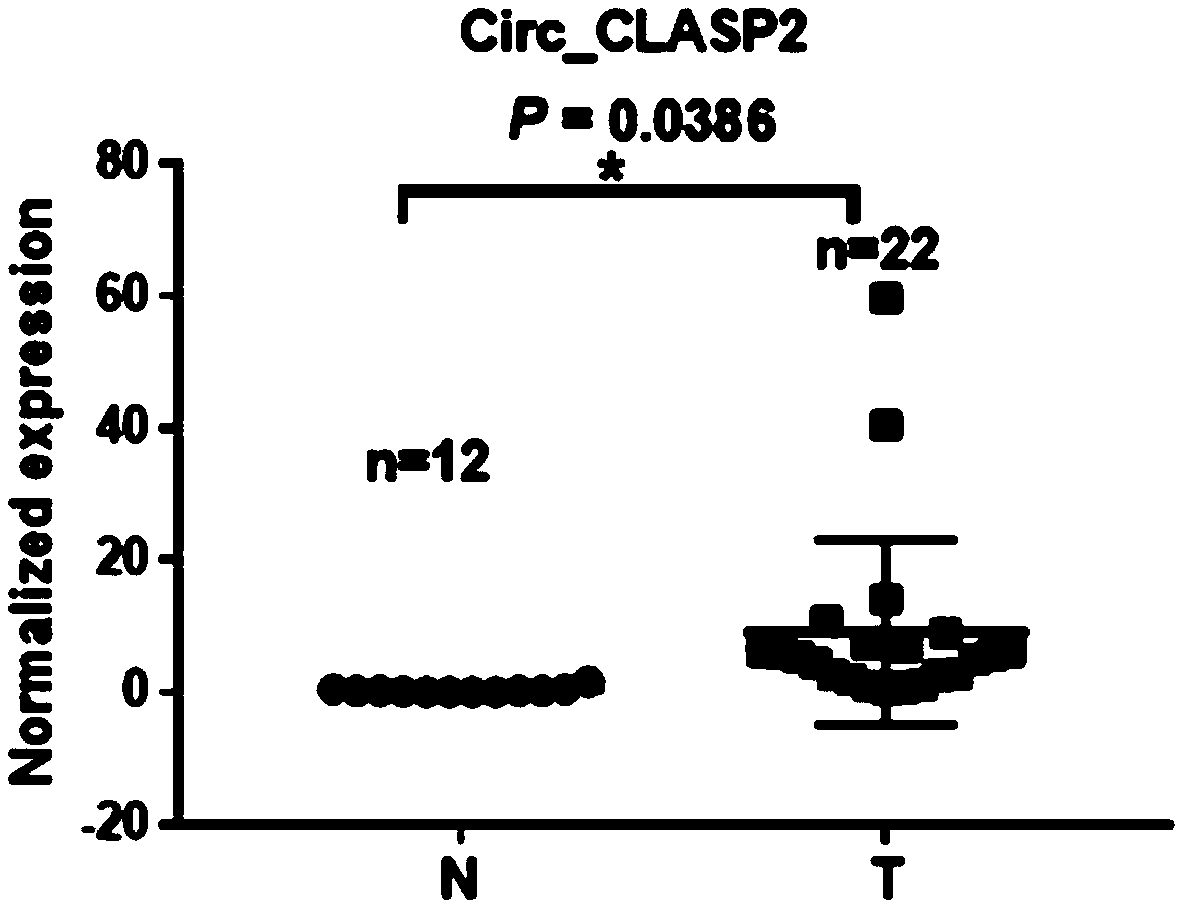Application of reagent for detecting circ_CLASP2 to preparation of nasopharynx cancer diagnosis preparation as well as kit
A nasopharyngeal carcinoma and kit technology, applied in the field of tumor molecular biology, can solve the problems of unclear molecular mechanism and insignificant curative effect, and achieve the effect of true and reliable results, rigorous test process and strict screening standards
- Summary
- Abstract
- Description
- Claims
- Application Information
AI Technical Summary
Problems solved by technology
Method used
Image
Examples
Embodiment 1
[0096] Example 1: Expression of circ_CLASP2 in nasopharyngeal carcinoma tissues and cells
[0097] 1. According to the standard sample collection plan, we collected 34 tissue samples from patients with suspected nasopharyngeal carcinoma from Hunan Cancer Hospital. All the cases were newly diagnosed patients in the Department of Head and Neck Surgery of Hunan Cancer Hospital (time interval: January 2016 to November 2016). 24 cases of nasopharyngeal carcinoma and 12 cases of nasopharyngeal inflammation were diagnosed by the pathology department (neoplastic diseases, no active infectious diseases, severe immune diseases and other major diseases have been excluded).
[0098] Complete personal information and clinical data were recorded during the collection process, including name, gender, age, outpatient number, hospitalization number, pathological type, case stage, and EBV infection, etc. See the screenshot of the Excel spreadsheet for details. All samples are collected with th...
Embodiment 2
[0135]Example 2 Detection of circ_CLASP2 overexpression effect in nasopharyngeal carcinoma cell lines
[0136] First, we select the enzyme cutting site, and put the full-length sequence of circ_CLASP2 (that is, the 449bp sequence of exons 2 to 6 of the CLASP2 gene) into the NEB cutter 2.0 online website for analysis, showing that the ClaI and SacII enzyme cutting sites are in the full-length sequence of circ_CLASP2 A site that does not exist, and a DNA restriction enzyme that is uniquely present in the pcDNA3.1 plasmid vector. Construct an overexpression vector accordingly; image 3 Map of the overexpression vector.
[0137] In order to test the overexpression efficiency of circ_CLASP2, we first expressed the constructed circ_CLASP2 eukaryotic overexpression vector in nasopharyngeal carcinoma cells. Nasopharyngeal carcinoma cells CNE2 and HNE2 in good growth condition were seeded into 12-well plates, and when the cell confluence reached 60%-80%, the endotoxin-free plasmid bl...
Embodiment 3
[0138] Example 3 Detection of the effect of silencing circ_CLASP2 expression in nasopharyngeal carcinoma cell lines
[0139] In order to ensure the rigorousness of the experiment, we designed two siRNA sequences of circ_CLASP2 according to the splicing site. siRNA is a type of 21-25 nucleotides in length, which can complement and bind with homologous RNA and specifically degrade the target RNA, thereby Double-stranded RNA molecules that inhibit their expression. At present, siRNA has developed into an important tool for the study of gene function. In order to explore the role of circ_CLASP2 in the development of tumors, we designed two siRNAs according to the splicing site of circ_CLASP2, and used Hiperfect reagent to combine siRNAs (siRNA1, siRNA2 and their mixture siRNA1+2) and an unrelated sequence as an experimental control (NC) Transient transfection into CNE2 and HNE2 cell lines silenced the expression of circ_CLASP2. Continue to culture for 48 hours after transfection...
PUM
 Login to View More
Login to View More Abstract
Description
Claims
Application Information
 Login to View More
Login to View More - R&D Engineer
- R&D Manager
- IP Professional
- Industry Leading Data Capabilities
- Powerful AI technology
- Patent DNA Extraction
Browse by: Latest US Patents, China's latest patents, Technical Efficacy Thesaurus, Application Domain, Technology Topic, Popular Technical Reports.
© 2024 PatSnap. All rights reserved.Legal|Privacy policy|Modern Slavery Act Transparency Statement|Sitemap|About US| Contact US: help@patsnap.com










